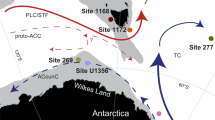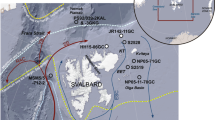Abstract
One of the most controversial results of the CLIMAP12 project's reconstruction of past sea surface temperature (SST) is that large areas of the subtropical Pacific Ocean were warmer during the last glacial period than they are today. This finding has important implications because SST patterns at low to subtropical latitudes strongly influence climate, and SST changes are closely linked with climate fluctuations3,4,5. Until now, a lack of well-preserved, high-resolution marine sediment cores from the region has hindered efforts to confirm these unexpectedly high ice-age SST estimates. Here we use both the oxygen-isotope compositions and species assemblages of planktonic foraminifera in a shallow-water core with high deposition rates near Hawaii to estimate glacial SST of the subtropical North Pacific Ocean. Contrary to the CLIMAP results2, our data indicate that the annual average SST in this region was ∼2 °C cooler during the last glaciation than it is today. These results help to reconcile the marine SST record with inferences drawn from snowline depressions on Hawaii during the last glacial3,6, and should ultimately yield improved estimates of global climate sensitivity by providing important new constraints on climate model simulations of ice-age cycles.
This is a preview of subscription content, access via your institution
Access options
Subscribe to this journal
Receive 51 print issues and online access
$199.00 per year
only $3.90 per issue
Buy this article
- Purchase on Springer Link
- Instant access to full article PDF
Prices may be subject to local taxes which are calculated during checkout



Similar content being viewed by others
References
CLIMAP Project Members. The surface of the ice-age earth. Science 191, 1131–1137 (1976).
CLIMAP Project Members. Seasonal Reconstruction of the Earth's Surface at the Last Glacial Maximum (Map and Chart Series MC-36, Geol. Soc. Am., Boulder, C, (1981)).
Rind, D. & Peteet, D. Terrestrial conditions at the Last Glacial Maximum and CLIMAP sea-surface temperature estimates: are they consistent? Quat. Res. 24, 1–22 (1985).
Webb, R., Rind, D. H., Lehman, S. R., Healy, R. J. & Sigman, D. Influence of ocean heat transport on the climate of the Last Glacial Maximum. Nature 385, 695–699 (1997).
Peteet, D., Del Genio, A. & Lo, K. K. -W. Sensitivity of northern hemisphere air temperature and snow expansion to North Pacific sea surface temperatures in the Goddard Institute for Space Studies general circulation model. J. Geophys. Res. 102, 23781–23791 (1997).
Porter, S. C. Hawaiian glacial ages. Quat. Res. 12, 161–187 (1979).
Tsutsui, B., Campbell, J. F. & Coulborn, W. T. Storm-generated, episodic sediment movements off Kahe Point, Oahu, Hawaii. Mar. Geol. 76, 281–299 (1987).
Hawaii Ocean Time-series database (cited 28 June (1998)) 〈ftp://mana.soest.hawaii.edu/pub/hot/ctd〉.
Woodruff, S. D., Slutz, R. J., Jenne, R. L. & Steurer, P. M. Acomprehensive ocean-atmosphere data set. Bull. Am. Meteorol. Soc. 68, 1239–1250 (1987).
Broecker, W. S. & Takahashi, T. The relationship between lysocline depth and in situ carbonate ion concentration. Deep-Sea Res. 25, 65–95 (1978).
Dulaney, T. S. & Sautter, L. R. Sedimentaiton of planktonic foraminifera: seasonal changes in shell flux north of Oahu Hawaii. Eos 76, 85–86 (1996).
Erez, J. & Lux, B. Experimental paleotemperature equation for planktonic foraminifera. Geochim. Cosmochim. Acta 47, 1025–1031 (1983).
GEOSECS Executive Committee GEOSECS Atlantic, Pacifi, and Indian Ocean Expeditions Vol. 7, Pacifi Shorebased Data and Graphics(National Science Foundation, Washington DC, (1977)).
Deuser, W. G. Seasonal and interannual variations in deep-water particle fluxes in the Sargasso Sea and their relation to surface hydrography. Deep-Sea Res. 33, 225–246 (1986).
Fairbanks, R. G. A17,000-year glacio-eustatic sea level record: influence of glacial melting rates on the Younger Dryas event and deep-ocean circulation. Nature 342, 637–642 (1989).
Schrag, D. P., Hampt, G. & Murray, D. W. Pore fluid constraints on the temperature and oxygen isotopic composition of the glacial ocean. Science 272, 1930–1932 (1996).
Spero, H. J., Bijma, J., Lea, D. W. & Bemis, B. E. Effect of seawater carbonate concentration on foraminiferal carbon and oxygen isotopes. Nature 390, 497–500 (1997).
Prell, W. L. The Stability of Low-latitude Sea-surface Temperatures: an Evaluation of the CLIMAP Reconstruction with Emphasis on the Positive SST Anomalies(Rep. No. TR025 (DOE/ER/60167-1), US Dept of Energy, Washington DC, (1985)).
Lyle, M., Prahl, F. & Sparrow, M. Upwelling and productivity changes inferred from a temperature record in the central equatorial Pacific. Nature 355, 812–815 (1992).
Beck, J. W., Récy, J., Taylor, F. & Edwards, R. E. Abrupt changes in early Holocene tropical sea surface temperatures derived from coral records. Nature 385, 705–707 (1997).
Guilderson, T. P., Fairbanks, R. G. & Rubenstone, J. L. Tropical temperature variations since 20,000 years ago: modulating interhemispheric climate change. Science 263, 663–665 (1994).
Sabine, C. L. & Mackenzie, F. T. Bank-derived carbonate sediment transport and dissolution in the Hawaiian Archipelago. Aquat. Geochem. 1, 189–230 (1995).
Manabe, S. & Broccoli, A. J. Acomparison of climate model sensitivity with data from the last glacial maximum. J. Atmos. Sci. 42, 2643–2651 (1985).
Ganopolski, A., Rahmstorf, A., Petoukhov, V. & Claussen, M. Simulation of modern and glacial climates with a coupled global model of intermediate complexity. Nature 391, 351–356 (1998).
Miller, J. R. & Russell, G. L. Ocean heat transport during the last glacial maximum. Paleoceanography 4, 141–155 (1989).
Horel, J. D. & Wallace, J. M. Planetary-scale atmospheric phenomena associated with the southern oscillation. Mon. Weath. Rev. 109, 813–829 (1981).
Wallace, J. M. & Gutzler, D. S. Teleconnections in the geopotential height field during the Northern Hemisphere winter. Mon. Weath. Rev. 109, 784–812 (1981).
COHMAP Project Members. Climatic changes of the last 18, 000years:observationsandmodelsimulations. Science 2241, 1043–1052 (1988).
Porter, S. C. Late Pleistocene eolian sediments related to pyroclastic eruptions of Mauna Kea volcano, Hawaii. Quat. Res. 47, 261–276 (1997).
Acknowledgements
We thank C. Sherman, B. Tsutsui and J. Tribble for help with sampling and discussions; M. Yeager for laboratory assistance; P. Howell, A. Martin and W. Prell for help with foraminifera taxonomy and MAT software; the National Ocean Sciences AMS Facility at Woods Hole for radiocarbon analyses; J. F. Campbell, C. Charles, T. Crowley, L. Keigwin and L. Sautter for discussions; and R. Webb for comments and suggestions. This work and core curation were supported by the NSF.
Author information
Authors and Affiliations
Rights and permissions
About this article
Cite this article
Lee, K., Slowey, N. Cool surface waters of the subtropical North Pacific Ocean during the last glacial. Nature 397, 512–514 (1999). https://doi.org/10.1038/17357
Received:
Accepted:
Issue Date:
DOI: https://doi.org/10.1038/17357
This article is cited by
-
High-resolution climate simulation of the last glacial maximum
Climate Dynamics (2008)
-
Persistence of full glacial conditions in the central Pacific until 15,000 years ago
Nature (2007)
-
Surface temperature control in the North and tropical Pacific during the last glacial maximum
Climate Dynamics (2004)
-
Seasonal changes in sea surface temperature of the subtropical North Pacific during the last glaciation
Geosciences Journal (2003)
-
Reassessment of ice-age cooling of the tropical ocean and atmosphere
Nature (1999)
Comments
By submitting a comment you agree to abide by our Terms and Community Guidelines. If you find something abusive or that does not comply with our terms or guidelines please flag it as inappropriate.



